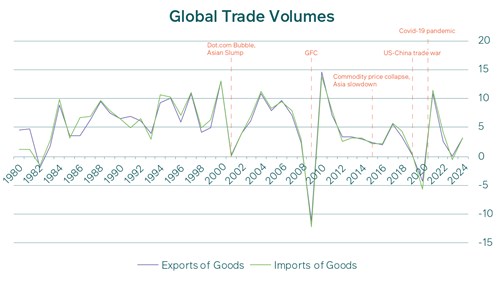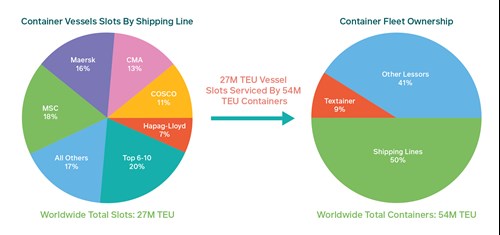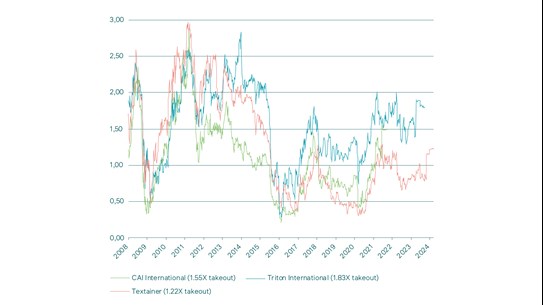Buoyant Textainer adds overlooked value for investors
Up until recent events like the Covid lockdowns, the Russia-Ukraine war, the Suez Canal blockage by the Ever Given, and the more recent Houthi rebel attacks in the Red Sea, most of us gave very little thought to how the products we use every day end up on our supermarket shelves.
Delays, increased shipping costs and product shortages, along with inflation, have once again highlighted the importance of containerised trade in our everyday lives. Seaborne transport is estimated to account for more than 70% of the total value of trade between countries, with container freight accounting for approximately 60% of the value of total seaborne trade. Yet, despite its important role in world trade, the history of the container is a surprisingly recent one.
The first standard shipping container was patented by Malcolm McLean in the US in 1956. In the ten years after the first container came into international use, the volume of international trade grew at twice the rate of global manufactured production.
Intermodal container shipping significantly lowered freight costs. Before containerisation, goods were handled manually as break bulk cargo. Multiple handling and delays at every port visit made transport expensive, time-consuming and unreliable.
Containerisation eliminated piece-by-piece freight handling costs and lowered loading times and transshipment costs. It enabled the seamless shifting of containers from ships to trucks and trains, and with other technological advances made it possible for companies like Toyota to develop and adopt just-in-time manufacturing. In short, the container was partly responsible for opening the US and European retail markets to Asian factories and facilitating global trade.
A cyclical industry
In South Africa, despite our geographic position as a historic hub of global seaborne trade, there are limited opportunities for investors to gain listed exposure to containerised trade and shipping.
It is an underrepresented, but also unloved, segment of the market as shipping is notoriously cyclical. There is a long lead time between ordering new ships and the eventual delivery, making it difficult to predict, while the high and bulky capital expenditure on long-duration assets makes it a difficult sector to navigate, especially as its fortunes are so closely tied to those of the global economy.
Graph 1: Global trade volumes highly cyclical (tonnes millions)

Source: Bloomberg, IMF WEO data
2001: “Dot.com” bubble, Asian slump
2009: GFC
2015: Commodity price collapse, Asia slowdown,
2019: US-China trade war
2020: Covid-19 pandemic
In addition, with the shipping industry accounting for an estimated 13% of the transport sector’s CO2 emissions or 1.6% of global greenhouse gas emissions, it is subject to increasing environmental regulations from the International Maritime Organisation (IMO) and regional regulators.
As a result, shipping lines have been investing in new ships powered by alternative fuels such as LNG and green methanol. At the end of 2023, 55% of the global containership order book was alternative-fuel capable. The green transition will require significant amounts of capex and lead to escalated costs due to elevated new-build prices and fuel costs. While a recent decline in sector profitability following the super-profits made in recent years could delay such green capex, the ability to offer carbon-neutral shipping solutions could drive differentiated pricing over time, protecting the return on investment for shipping companies.
Other initiatives to manage emissions include slow steaming as well as retrofitting energy-saving technologies (scrubbers) on ships. Slow steaming is also used to manage capacity in downturns and is positive for container lessors as containers are tied up for longer periods, increasing the overall demand for containers.
In contrast to shipping where there is a hesitancy to invest due to continuous technological developments coupled with the long lead time of ship orders, uncertainty around the standard alternative fuel of the future, and a lack of clarity around the decarbonisation pathway, the lead time for new containers is very short and this segment of the sector is very agile and responsive to changes in global demand.
The container leasing market overview
Textainer, formerly listed in New York and South Africa, is the second-largest lessor of intermodal containers in the world, and as of the end of 2023 had a fleet of around 4.3 million twenty-foot equivalent units (TEUs, a unit of measurement based on the length of a container relative to a standard 20’ dry freight container).
Textainer leases out containers primarily to shipping lines. For shipping lines, the flexibility to on-hire or off-hire containers at different locations allows them to meet fluctuating demand requirements. For a capital-intensive industry with significant cash requirements for vessels, scrubber retrofitting, and other expenses such as terminals and fuel costs, this acts as an alternative source of financing.
Graph 2: The global container leasing market

Source: Company presentation p.29, August 2023
Our investment case: A case study
Our funds originally gained exposure to Textainer (at the time a NYSE-listed entity) through our shareholding in Trencor, a JSE-listed entity. Trencor held approximately 47.5% of Textainer’s shares (27.2 million common shares) and unbundled these shares to Trencor shareholders in phases in December 2019 and June 2020 for implied rand-denominated Textainer share prices of R133.00 and R144.20, respectively. At the time of these unbundlings, Textainer was trading below US$ 9.00 per share, at only 40% of its book value.
Our investment case at the time was simple. Textainer was regarded as a cyclical company that had fallen out of favour with the market and was trading at a significant discount to its peers and own history. The company had a solid asset base and a new management team that was focused on capital discipline and matching fixed-rate rental revenue to fixed-rate financing in both duration and terms to limit volatility and lock in long-term profitability.
To an extent, the discount to its book value at the time could be explained by it being a low point in the cycle and Textainer at the time being structurally less profitable than its peers due to historic errors in its investment cycle.
Looking back, Textainer invested heavily in containers at a time when steel and container prices were at cyclical highs in 2012. These containers were purchased at expensive levels and leased out on short-term leases that came up for renewal when the market had bottomed in 2015-2016. Combined with this, one of Textainer’s large customers, the Korean company Hanjin Shipping, filed for bankruptcy. Once the market turned for the better, Textainer was already over-leveraged and frozen out of their financing facility, and as a result, could not take advantage of the improved conditions to buy more containers and lease them at much more favourable rates. Also, it took them years to recover their containers from Hanjin and to receive the insurance payout, too late to capitalise on the market upturn These developments impacted significantly on their profitability in subsequent years.
It was with these events in mind that most investors regarded Textainer as a lower quality company than its peers CAI International and Triton International. Our quarrel with the market was that these historic errors were not to be repeated and that Textainer’s return on equity would improve over time as the lower-priced leases came up for renewal and the matching of lease and finance terms improved.
With a bit of luck, these changes occurred earlier than expected. After the Covid slowdown and trade disruptions, the demand for containers increased significantly, and as an early investor, Textainer was able to significantly increase its container fleet and lease these containers out at favourable long-term leases of 12-15 years, matched with long-duration fixed-rate financing. This significantly reduced the group’s repricing risk on lease expiry (where the new lease rates could possibly be lower than the expiring ones due to lower container prices at the time of renewal) as the average lifespan of a container is 13-14 years and thus was now better matched to the initial lease term. The average duration of Textainer’s leases increased from 3.3 years in 2016 to more than 6 years in 2023.
As a result, the US dollar return on equity for Textainer increased to above 15%, and yet the share price did not reflect this and remained well below fair value. Management demonstrated remarkable capital discipline, and in the absence of lucrative investment opportunities, aggressively bought back shares at a discount, buying back more than 30% of Textainer shares from 2019-2023 at below 60% of book value. We were fully supportive of these buybacks and maintained our overweight position in the stock.
In the meantime, its listed peers caught the eye of infrastructure and other investors. In November 2021, Mitsubishi HC Capital, which already owned Beacon Intermodal Leasing, acquired CAI International for a price-to-book value multiple of 1.55X. In April 2023, Brookfield Infrastructure Partners announced the acquisition of Triton International for a price-to-book value multiple of 1.83X, a 35% premium to the previous day’s closing price.
Textainer was the last large, listed player left standing.
Then in October 2023, it was announced that Textainer was to be acquired by the alternative investment firm Stonepeak for an enterprise value of $7.4 billion, or a per share price of $50 in an all-cash offer, representing a premium of 46% over Textainer’s closing share price on 20 October 2023. This represented a price-to-book value multiple of 1.22X. The definitive merger agreement included a 30-day “go-shop” period where Textainer could solicit alternative acquisition proposals. In addition, Textainer maintained its quarterly dividends up until the date of closing.
We held on to our position in Textainer in this “go-shop” period, as we believed this to be a floor value for the company. No alternative proposal was received, and the merger agreement was approved by shareholders on 5 January 2024. Most of our funds sold out of our positions prior to the delisting on the JSE on 14 March 2024 at a favourable price, discounting the time to payment and dividends until delisting, and thus received the full benefit of the 46% premium to the listed price before the announcement.
Graph 3: Price-to-book value ratios: Textainer, CAI and Triton

Source: Bloomberg
Adding investor value
Simplistically speaking, we acquired “pure” Textainer exposure at below US$9.00 per share in December 2019 and in June 2020 and sold it for US$50 per share in early 2024, representing appreciation of some 455% in just over four years in US$ terms, excluding any dividends. In rand terms, investors would have received a return of over 600% – also excluding dividends. Textainer proved to be an excellent investment for our clients, with our overweight exposure spread across several of our unit trusts, including the M&G Equity Fund, M&G Balanced Fund and M&G Inflation Plus Fund. It was one of the largest equity contributors to these funds over the latest rolling three-year period, showing how important the identification of overlooked – or underappreciated – value can be.
Sources:
https://blogs.worldbank.org/en/transport/why-ports-matter-global-economy
https://www.oecd.org/ocean/topics/ocean-shipping/
https://www.oecd-ilibrary.org/sites/508bfb5b-en/index.html?itemId=/content/component/508bfb5b-en
https://unctad.org/publication/review-maritime-transport-2023
Share
Did you enjoy this article?
 South Africa
South Africa Namibia
Namibia




 Get the Newsletter
Get the Newsletter